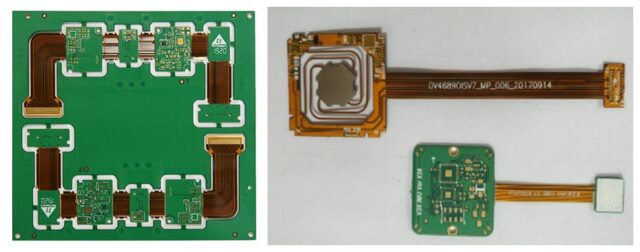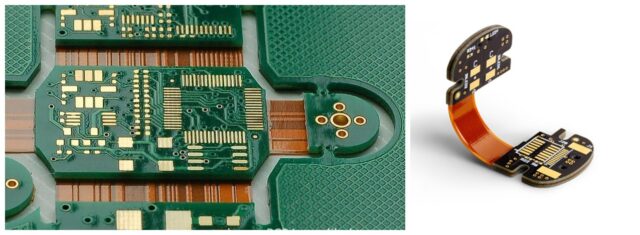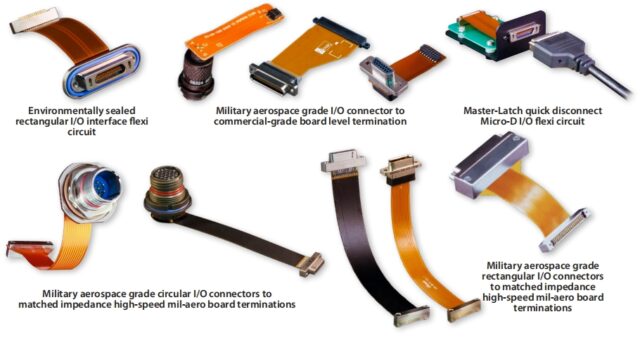Product Category: Multi-Layer Rigid-Flex PCB
Structure: 3F + 5R (8-layer 2-step HDI)
Minimum Line/Spacing: 0.1/0.1 mm
Minimum Hole Size: 0.1 mm
Applications: High-end industrial sensor control, advanced electronics, aerospace, medical devices

KKPCB Manufacturing Capabilities
At KKPCB, we specialize in designing and manufacturing high-reliability rigid-flex PCBs. Our capabilities include:
-
Layer Count: 1–16 layers (currently producing up to 8-layer HDI rigid-flex PCB)
-
Materials: PI (0.5–2 mil), PET, PEN
-
Copper Thickness: 1/3 oz – 2 oz
-
NPTH Hole Tolerance: ±0.025 mm
-
PTH Hole Tolerance: ±0.05 mm
-
Finished Board Thickness Tolerance: ±0.01 mm
-
Minimum Line/Space: 0.05/0.05 mm
-
Surface Finishes: Anti-oxidation, ENIG, Immersion Gold, Lead-Free HASL, Electroless Tin
-
Ni/Au Thickness: Ni: 2.54–6 μm, Au: 0.025–0.125 μm
With years of experience in rigid-flex PCB design and production, KKPCB provides full DFM/DFT support, helping clients optimize their designs for manufacturing, assembly, and long-term performance.

What is a Rigid-Flex PCB?
A Rigid-Flex PCB combines rigid PCB layers and flexible PCB layers into a single board through advanced lamination processes. Flexible sections are designed to bend, while rigid sections provide structural durability. This hybrid design allows:
-
3D assembly in limited spaces
-
Weight reduction
-
High reliability under dynamic or harsh conditions
Rigid-Flex PCBs are widely used in industrial control, medical electronics, military, aerospace, and high-end consumer devices.
Advantages of KKPCB Rigid-Flex PCBs
-
Space-Saving Design: Flexible sections allow folding and stacking to minimize device volume.
-
Durability: Resistant to high/low temperatures, fire, and chemical exposure.
-
Flexibility: Supports repeated bending without affecting electrical performance.
-
Enhanced Reliability: Larger soldering areas reduce potential failures compared to pure flexible PCBs.
-
Ease of Assembly: Reduces assembly errors and time, improving product lifespan.
-
Weight Reduction: Optimizes product weight without compromising performance.
-
Customizable Solutions: Supports complex geometries for specialized industrial applications.

KKPCB Rigid-Flex PCB Design Guidelines
Our engineers follow strict design rules to ensure high reliability:
-
Via and Hole Placement: Avoid vias in high-flex regions; maintain safe distances from stiffeners.
-
Pad & Via Design: Use teardrop-shaped pads and mechanical anchors for durability.
-
Circuit Layout: Flex layers use smooth curved traces; avoid overlapping top and bottom layer circuits in bending regions.
-
Copper Pour & Planes: Optimize copper distribution to balance flexibility and electrical performance.
-
Rigid-Flex Transition: Ensure smooth conductor paths; avoid PTH in critical flex areas.
-
Bending Radius: Minimum radius is calculated based on thickness and number of layers: single-layer ≥6×T, double-layer ≥12×T, multi-layer ≥24×T; absolute minimum 1.6 mm.
For detailed guidelines, KKPCB follows IPC-D-249 and IPC-2233 standards to ensure reliable and high-quality manufacturing.
Applications of KKPCB Rigid-Flex PCBs
Our 8-layer rigid-flex HDI PCBs are widely used in:
-
Industrial Sensors & Controllers – High-precision monitoring and control
-
Medical Devices – Pacemakers, diagnostic equipment, wearable medical electronics
-
Automotive Electronics – ADAS modules, in-car sensors, radar systems
-
Aerospace & Defense – High-reliability, lightweight, and compact electronics
-
Consumer Electronics – Cameras, laptops, smartphones, printers, and more
KKPCB rigid-flex PCBs maximize space utilization, reduce weight, and improve signal reliability, making them ideal for cutting-edge electronics.
Why Choose KKPCB?
-
Expertise: Over 20 years of experience in rigid-flex PCB design and production
-
Advanced Manufacturing: Support for 2–16 layer rigid-flex PCBs, high-density HDI, and precise tolerances
-
Custom Design Support: DFM/DFT analysis for optimized reliability and performance
-
High-Quality Standards: Strict IPC-compliant processes and surface finishes
With KKPCB, your rigid-flex PCB projects—from prototyping to mass production—receive professional design, high-quality manufacturing, and reliable technical support.
Contact KKPCB today to discuss your custom rigid-flex PCB needs and achieve superior performance for your high-end electronics applications.


